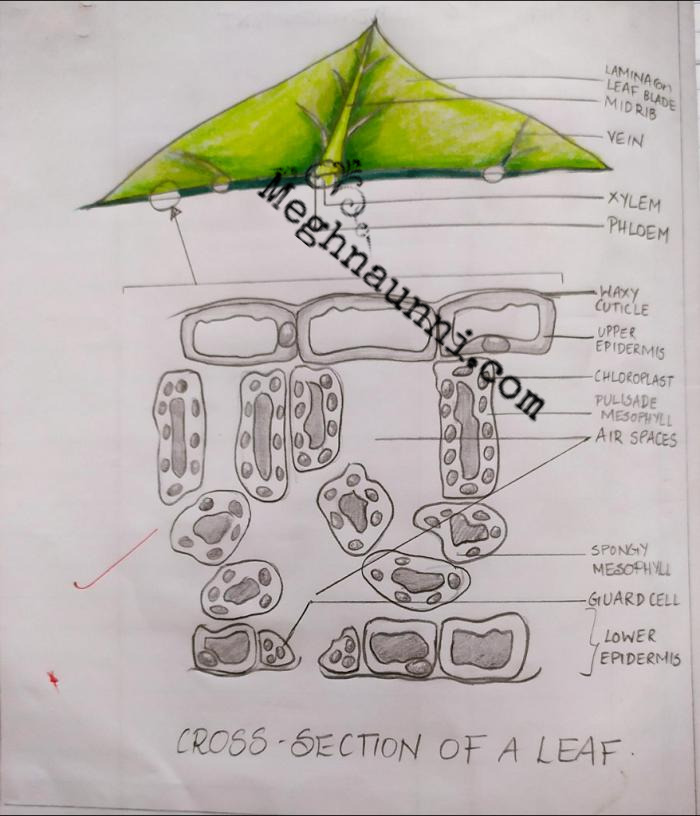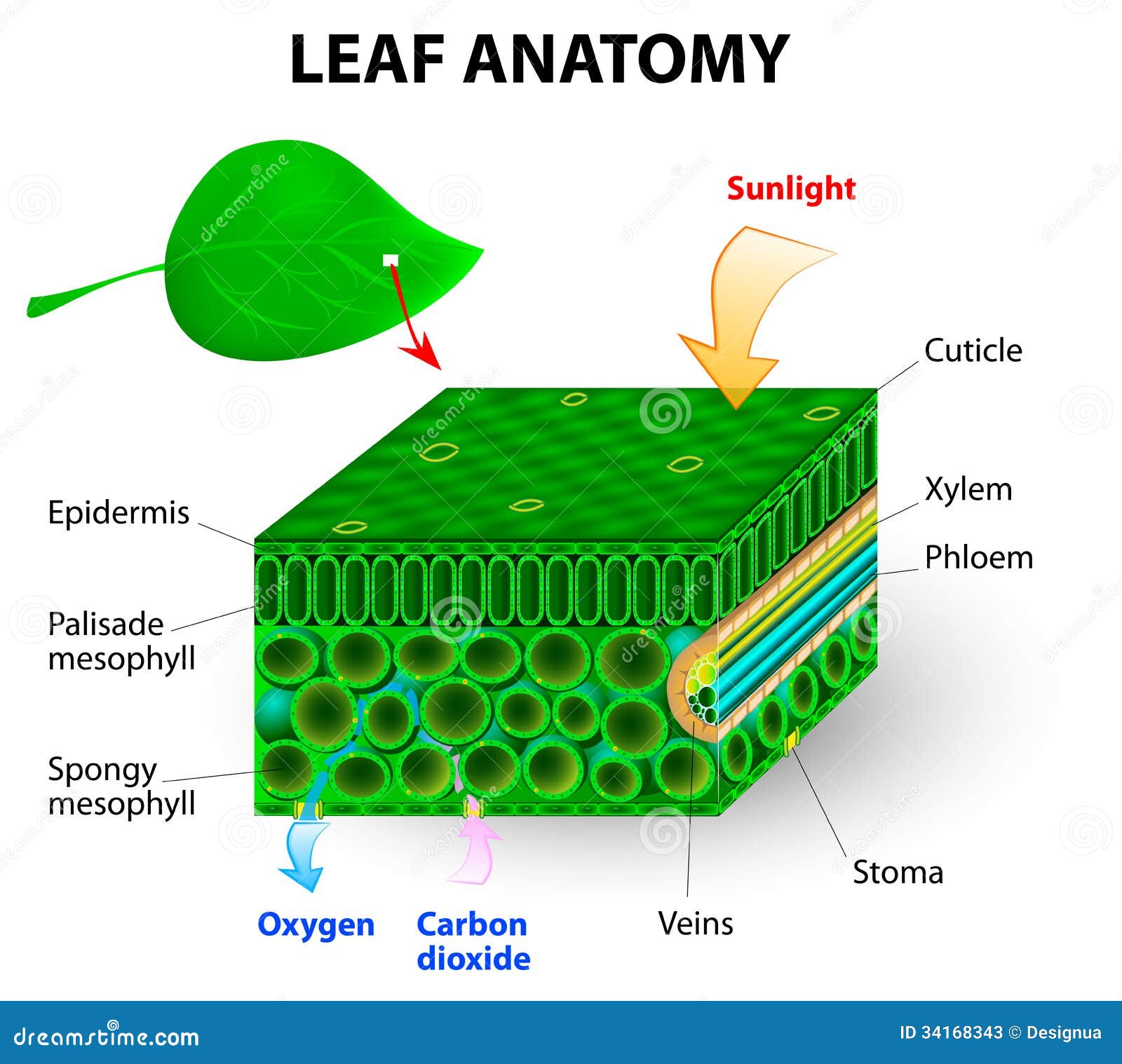
Anatomy of a Leaf Diagrams 101 Diagrams
Figure 30.8.1 30.8. 1: Parts of a leaf: A leaf may seem simple in appearance, but it is a highly-efficient structure. Petioles, stipules, veins, and a midrib are all essential structures of a leaf. Within each leaf, the vascular tissue forms veins. The arrangement of veins in a leaf is called the venation pattern.

Draw a labelled diagram of the external structure of a leaf. Brainly.in
Read the plant definitions below, then label the simple leaf morphology diagram below. axil - the angle between the upper side of the stem and a leaf or petiole. lamina - the blade of a leaf. leaf apex - the outer end of a leaf; the end that is opposite the petiole. midrib - the central rib of a leaf - it is usually continuous with the petiole.

Parts of a Leaf, Their Structure and Functions With Diagram Parts of
Label the leaf Quiz Key points The leaf is one of the most important organs of a plant. Leaves produce food for the plant through a process called photosynthesis. The leaves of different.

Parts of a Leaf YouTube
The air space found between the spongy parenchyma cells allows gaseous exchange between the leaf and the outside atmosphere through the stomata. In aquatic plants, the intercellular spaces in the spongy parenchyma help the leaf float. Both layers of the mesophyll contain many chloroplasts. Figure 30.10. 1: Mesophyll: (a) (top) The central.

Labeled Diagram Of A Leaf
The midrib contains the main vein (primary vein) of the leaf as well as supportive ground tissue (collenchyma or sclerenchyma). Figure 3.4.1. 1: A typical eudicot leaf. Many leaves consist of a stalk-like petiole and a wide, flat blade (lamina). The midrib extends from the petiole to the leaf tip and contains the main vein.

Cross Section of a Leaf Biology Diagram
WJEC Structure of plants - WJEC Leaf structure Plants adapt in order to efficiently collect raw materials required for photosynthesis. These raw materials must be transported through the plant.
:max_bytes(150000):strip_icc()/leaf_crossection-57bf24a83df78cc16e1f29fd.jpg)
Plant Leaves and Leaf Anatomy
Diagram showing the cross-section of a leaf. The specialised cells in leaves have adaptive features which allow them to carry out a particular function in the plant;. 6.2.3 Structure of the Leaf; 6.2.4 Living in Extreme Conditions; 6.3 Transport in Plants. 6.3.1 Transport of Water & Mineral Ions;
leaf structure Labelled diagram
Help your learners identify the various parts of a leaf with this handy activity. It includes a labelled poster, which could also be displayed on your classroom wall. Students use this to label their own blank leaf diagram. What are the parts of a leaf? - Blade - Tip - Petiole - Midrib - Vein - Margin - Stipules. How will this activity be useful?
/parts_of_a_leaf-56abaed23df78cf772b5625a.jpg)
Plant Leaves and Leaf Anatomy
A leaf diagram representing the parts of a leaf Read more: Types of Stipules Venation Venation is defined as the arrangement of veins and the veinlets in the leaves. Different plants show different types of venation. Generally, there are two types of venation:

Changing Seasons, Fall Leaves, and Your Car's Paint
Parts of a Leaf Diagram 1. Petiole It is the stalk that connects a leaf to the stem of the plant, it is made of complex conducting tissues called vascular tissues. Functions Providing support to the leaf and keeps it erect Transporting water and nutrients absorbed by the roots to the leaves

Labeled Diagram Of A Leaf hubpages
Leaf Parts. Leaves are generally composed of a few main parts: the blade and the petiole. Figure 13.1.2 13.1. 2: A leaf is usually composed of a blade and a petiole. The blade is most frequently the flat, photosynthetic part. The petiole is a stem that attaches the leaf blade to the main stem of the plant.

Leaf anatomy stock illustration. Illustration of lower 34168343
1. Pulvinus: ADVERTISEMENTS: In some plants, e.g., legumes, tamarind, Mimosa (Fig. 4.2-A), mango, banyan, gold- molhur etc., the leaf base becomes distinctly swollen and forms a broadened cushion-like structure, the pulvinus, (Fig. 4.2.-8). 2. Sheathing Leaf Base:

Dicot leaf Biology plants, Plant science, Plant physiology
Figure 9.3. 2: Cross section of a hydrophytic leaf. Observe a prepared slide of a hydrophyte, such as Nymphaea, commonly called a water lily. Note the thin epidermal layer and the absence of stomata in the lower epidermis. In the spongy mesophyll, there are large pockets where air can be trapped.

describe the structure of the leaf with the help of a neat well
Definition of a Leaf 2. Parts of a Leaf 3. Types. Definition of a Leaf: The leaf is a flattened, lateral outgrowth of the stem in the branch, developing from a node and having a bud in its axil. It is normally green in colour and manufactures food for the whole plant.

Leaf Labelled Stock Photo Download Image Now iStock
1. What is the Leaf Cross Section? Leaves are the powerhouse of plants as they prepare food by the process of photosynthesis. In the presence of water and carbon dioxide, the chlorophyll present in the leaves converts the energy of the sunlight into sucrose and water. The structure of the leaves helps in the regulation of the whole process.

Leaves Biology for Majors II
Like the stem, the leaf contains vascular bundles composed of xylem and phloem (Figure 3.4.2.6 − 7 3.4.2. 6 − 7 ). When a typical stem vascular bundle (which has xylem internal to the phloem) enters the leaf, xylem usually faces upwards, whereas phloem faces downwards. The conducting cells of the xylem (tracheids and vessel elements.